Friday’s jobs data showed strong demand for workers as 678k new jobs were created and the unemployment rate fell to 3.8%, just above the pre-pandemic low of 3.5%. While this is certainly good news, the increase in hires will not much diminish the near-record job openings in the United States. Two questions arise: what is causing the US labor shortage and how can businesses respond?
Stating the obvious, the negative impact of COVID-19 has not been exclusive to individuals or the public health sector. The pandemic has also triggered global disruptions in economic conditions, causing major supply chain and labor market shortages. In this regard, the U.S. has been hit exceptionally hard. Today, the country suffers an unusual shortage of labor. While the demand for workers is rising as the economy recovers, the same cannot be said for labor supply, which has been on the downtrend. A rapid increase in vacancies is met by a puzzling unwillingness to work. The problem is especially severe in industries such as leisure and hospitality, manufacturing, and healthcare, ranging from a shortage of servers in restaurants to a lack of nurses in hospitals.
Prior to the pandemic, the unemployment rate in the U.S. stood at 3.5%, with only 7.4 million job openings and 7.1 million Americans unemployed. Last December, 10.9 million unfilled vacancies were on the market, according to the Bureau of Labor Statistics. Yet only 6 million were unemployed, which is lower than the pre-pandemic unemployment level. A question that is puzzling experts is “where did the workers go?”
Americans today are voluntarily quitting their jobs at an unprecedented rate, a phenomenon that has been referred to as the “Great Attrition.” The U.S. quits rate was at 3% at the end of 2021, compared to around 2% just before the pandemic, and increasing at a higher trend than before the outbreak of COVID-19. The rate of quitting, however, has been rising even before the crisis. In August 2009, the quits rate was only 1.20%. So, if anything, the pandemic might have accelerated a structural shift that has been building up for some time.
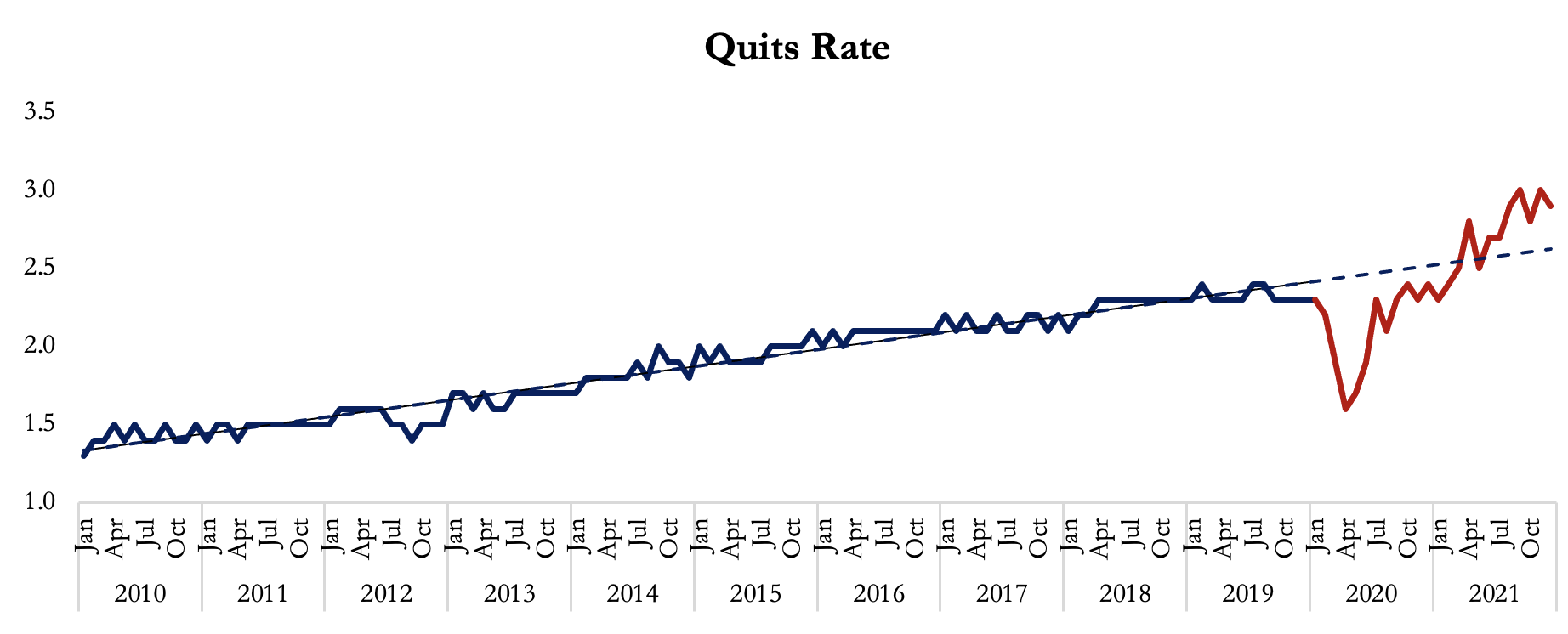
Source: Bureau of Labor Statistics.
There is no doubt that the pandemic has massively impacted the U.S. economy. In June 2020, real Gross Domestic Product, which measures the economy’s total production of goods and services, fell at an unprecedented rate of 31.2%. This was almost 4 times the drop in 2008. Unemployment rate also exploded to a record high of 14.7% in April 2020, compared to a maximum of 10% during the global financial crisis.
With such a significant shock, experts and policymakers expected a very slow recovery to follow. Nevertheless, the U.S. economy showed an impressive comeback. By 2021, real output surpassed the pre-pandemic rate as it grew at an average rate of around 6%. Unemployment also recovered rapidly, reaching 3.9% by December 2021, only 0.4 percentage points higher than the pre-pandemic rate.
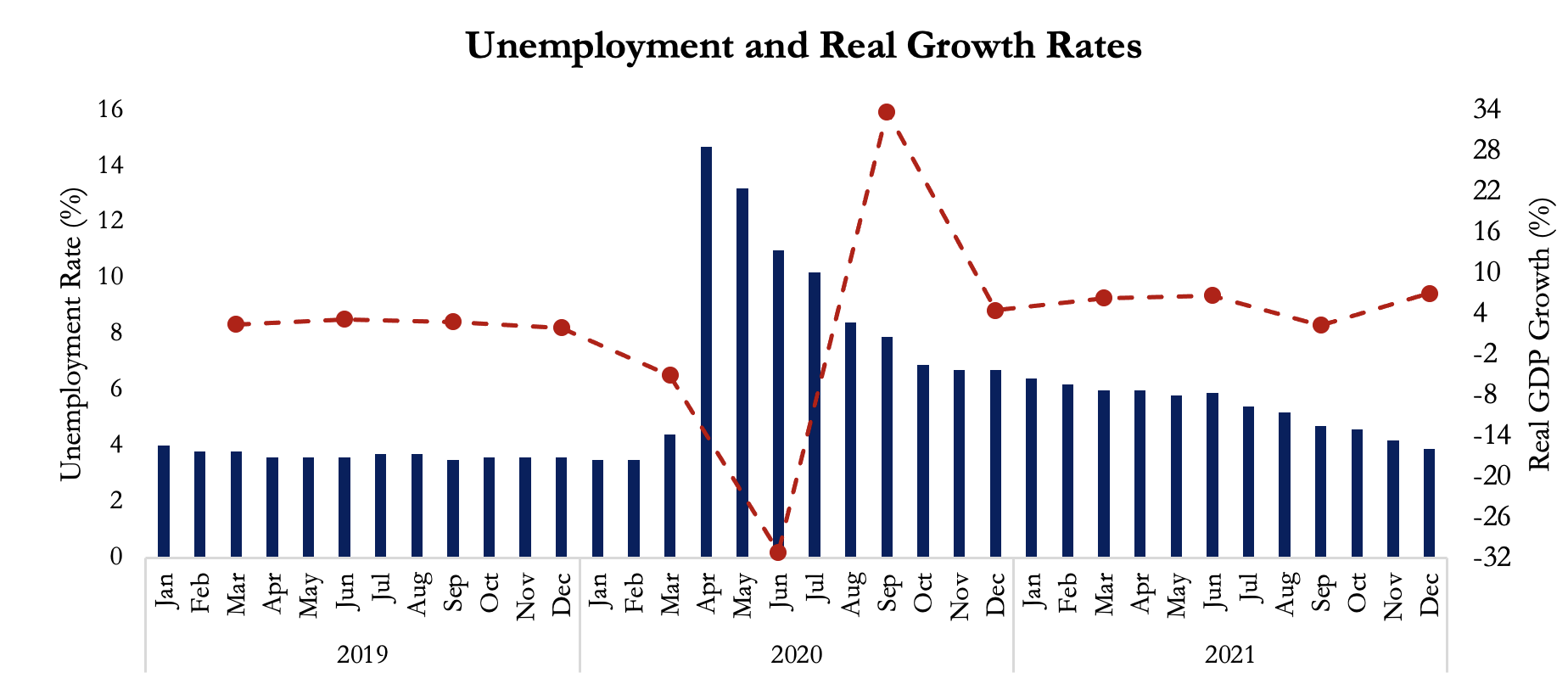
Source: Bureau of Labor Statistics and Bureau of Economic Analysis.
At a first glance, the labor market might portray a promising picture. Yet, businesses are unable to find the required workers as demand outstrips supply. On the demand side, the number of job openings has been rapidly increasing since the start of 2021, recording 10.9 million vacancies in December and an all-
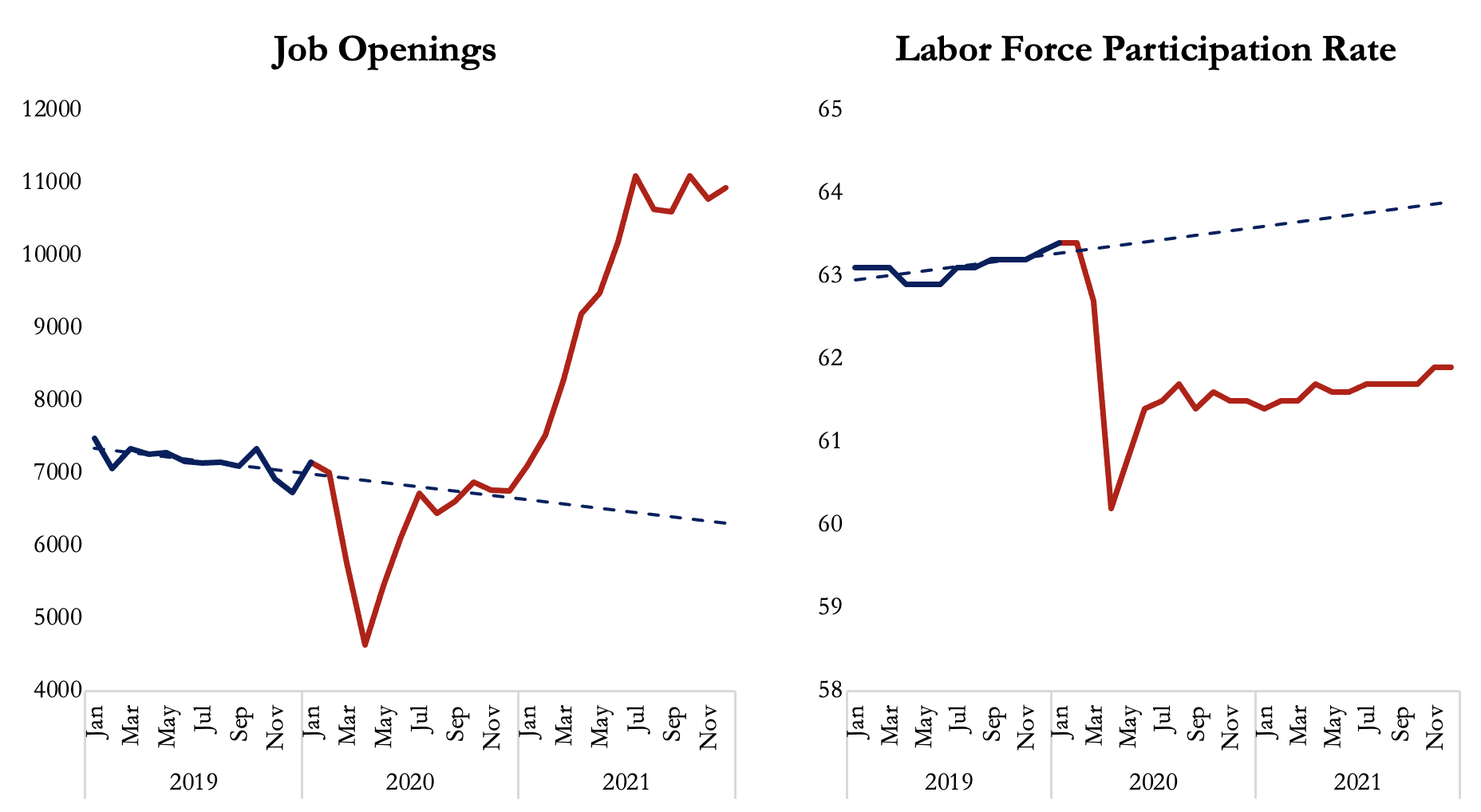
Source: Bureau of Labor Statistics.
time high of 11.1 million in July and October (left graph below). On the supply side, however, the labor force participation (LFP) rate has not fully recovered to its pre-pandemic level (right graph below). The labor force participation rate refers to the proportion of the population that is either working or actively looking for a job. So, a reduction in the LFP would usually reflect an unwillingness to accept jobs. In April 2020, LFP stood at 60.2%, the lowest rate on record, compared to 63.4% prior to the pandemic. In December 2021, LFP slightly increased to 61.9%, recovering only half its loss.
Several factors could be driving the mismatch of labor supply and demand. Some are pandemic-related, and thus should gradually resolve themselves as COVID-19 recedes, others are more ingrained structural issues. A recent analysis by Standard & Poor’s estimated that almost 58% of the decline in the labor force participation rate is due to pandemic-related reasons that are most likely temporary. The remaining 42% are related to structural shifts in the U.S. market, which will probably linger over the long term. We will take a look at some of the structural shift issues.
Demographics and a Rise in Early Retirement
Thanks to the Baby Boomers – those born between 1946 and 1964 – starting to retire in 2008, the U.S. workforce has been aging fast. The share of the working-age population, those between 15 and 64 of age, has been declining for decades. This means that as fewer people have children and more retire, the country’s labor force will likely shrink.
While this structural change has been in the process for a while, the COVID-19 virus indeed accelerated the transition. The higher health risks, as well as the increasing asset and house prices, certainly pushed many older Americans to retire early, a decision that might have been delayed if it weren’t for the pandemic. The Federal Reserve Bank of St. Louis estimated that, as of November 2021, there were 2.4 million excess retirees due to the pandemic, over the normal trend. This represented almost 50% of the 4.2 million Americans who left the labor force since the start of COVID-19.
The graph below shows the share of the older Americans (55 years and above) not in the labor force (NLF) relative to the total population of the same age. During the pandemic, the proportion of those above 55 who dropped out of the labor force substantially increased to an all-time high of 61.9% in January 2021. Although it slightly dropped by the second half of the year, it is still far above the pre-pandemic trend (blue dashed line). Moreover, contrary to a decreasing pre-pandemic trend, it is now shooting upwards (red dashed line).
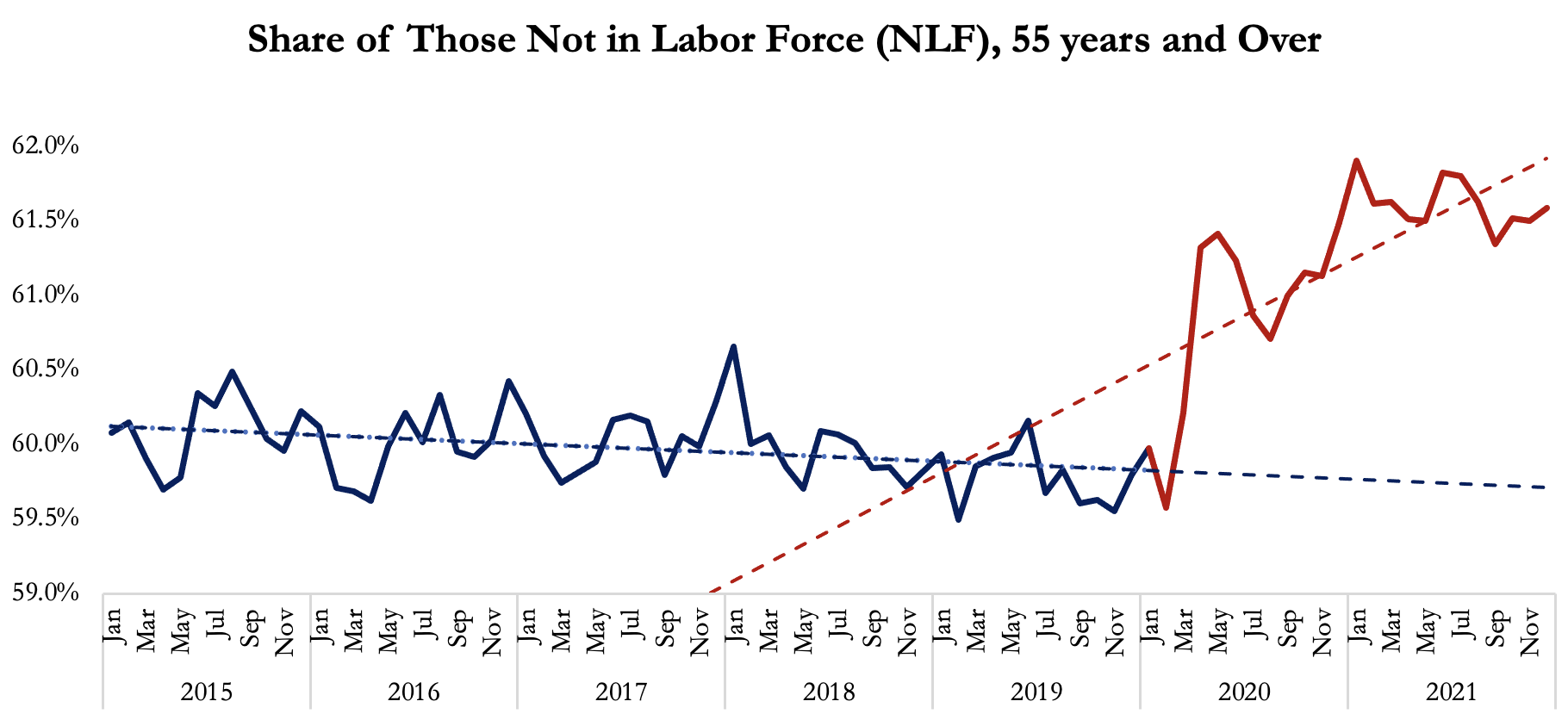
Source: Bureau of Labor Statistics.
According to a recent study by the International Monetary Fund (IMF), retirement was the main driver behind the rising inactivity among old workers in the U.S. during the pandemic. Moreover, the higher retirement rate was evident for Americans of different income levels.
The She-Cession and High Cost of Childcare
Another major factor behind the shortage of workers is the loss of a big portion of female workers due to family responsibilities. Hindered by the high cost of childcare, many mothers face a tradeoff between work and childcare. U.S. childcare services have been expensive even prior to the pandemic, preventing access by many low-income families to its services. The emergence of COVID-19, and the consequent extended school closures and temporary or permanent shut down of many centers, has pushed the cost of childcare even higher. Mothers are concerned about their kid’s health, and this has left them no choice but to quit their jobs in order to care for their children at home; a phenomenon often referred to as the “She-Cession.” The IMF estimated that mothers of children younger than 5 years old were responsible for almost 16% of the U.S. employment gap between October 2021 and the pre-pandemic levels, down from 23% in September.
The graphic below shows the evolution of the share of women not in the labor force. Post pandemic, the proportion has increased to a high of almost 62%, almost 2 percentage points above the pre-pandemic trend. Although the proportion of women out of the labor force is now at a higher average, its trend is increasing at a slower pace than that for older workers, implying a possibly more temporary issue. Indeed, this problem should gradually fade as the pandemic eases and more vaccinations are rolled out. Although vaccines are now available for children over the age of 5, younger kids remain at risk. Moreover, some people are still reluctant to get themselves and their kids vaccinated.
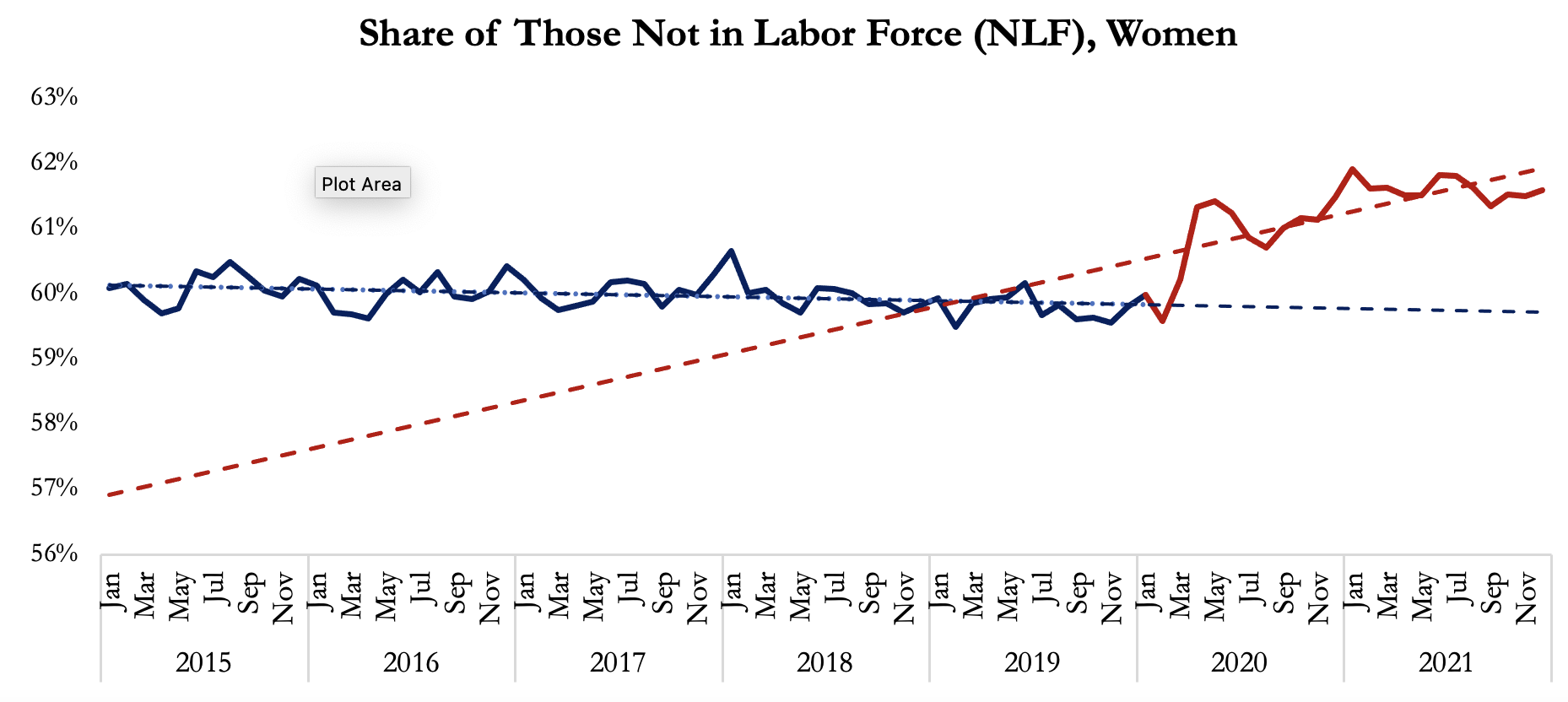
Source: Bureau of Labor Statistics.
Higher Inflation Is Eating Away Paychecks
A rising tide does not necessarily lift all boats. Despite the economic expansion and the rise in labor productivity in the U.S., American workers are not reaping their rewards. The U.S. labor market has been plagued by substandard pay rates even before the pandemic. Over the last 5 decades, the ratio of wages to total output has been declining. In 2019, the share of wages and salaries to GDP was only 43.6%, compared to a peak of 51.1% in 1970 (Below chart, blue line). This decline happened despite the rapid increase in average labor productivity. Between 1970 and 2019, real GDP to the number of persons employed increased at a compound annual growth rate (CAGR) of 25% (Below chart, red line).
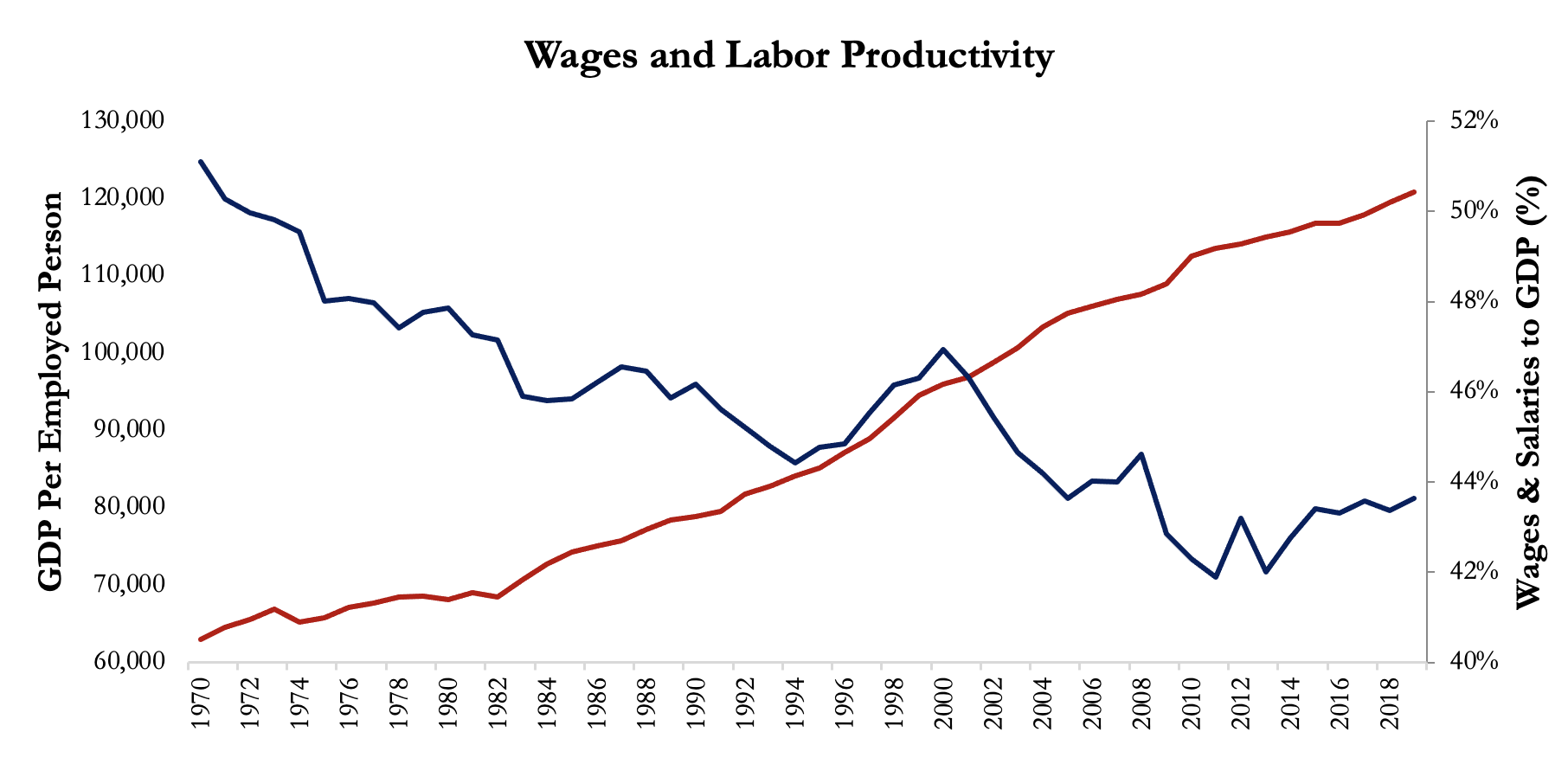
Source: Bureau of Labor Statistics, Bureau of Economic Analysis, and Federal Reserve Bank of St. Louis.
While the suboptimal labor conditions might have been acceptable in the past, the pandemic changed the playing field. Today, going to work poses a greater burden on employees, whether due to the high risk of contracting the virus or the increasing cost of childcare. Accordingly, the reservation wage – the minimum wage required by a worker to accept a job – is now higher.
This problem is even aggravated by the rising inflation rates. U.S. annual inflation rate recorded 7.5% in January 2022, representing the highest rise in 40 years. With such a high surge in prices, Americans are refusing to accept jobs at previous pay rates. With inflation surpassing the wage growth rate, real wages after deducting the effect of price increases, are becoming negative. In addition, as companies continue to raise wages this even pushes prices further up, exacerbating the problem as the country enters a vicious wage-inflation spiral.
Mismatches in Location and Skill
Many Americans relocated during the pandemic as they either worked remotely or lost their jobs. Net migration into metropolitan areas was higher in 2020 than 2019, with most relocations being to suburbs as opposed to cities. Now that businesses are looking to refill their vacancies, such location mismatch is not helping, especially with the restricted mobility during the pandemic. The loss of foreign immigrants is also a contributing factor. Immigration trends have slowed down worldwide due to lockdowns and health threats. According to economists at the University of California Davis, the U.S. lost around 2 million working-age immigrants due to COVID-19, compared to the pre-pandemic trend. Half of those immigrants would have been college-educated.
A mismatch of skills might have also contributed to the problem. Industries were impacted differently by the pandemic. While sectors such as manufacturing or leisure and hospitality were hit the hardest, others such as telecommunications fared well. It might be that people who lost their jobs in specific industries do not have the required skills to transition into other vacant industries. Moreover, as the virus threats still loom, workers might be reluctant to get back to hazardous jobs that require frequent in-person interactions. At least, not under the current labor market pay and conditions. According to the IMF, the mismatch story can explain around 18% of the U.S. employment gap. This mismatch, however, is smaller than during the Global Financial Crisis.
Are Unemployment Benefits to Blame?
The generous government support system is often accused of being a root cause behind the high labor shortage. Several unemployment incentive programs were put in place during the pandemic. The Federal Pandemic Unemployment Compensation (PUC) provided a payment of $600 a week for the unemployed between March and July 2020, which was later extended in December 2021 to provide an extra $300 per week. The Pandemic Emergency Unemployment Compensation (PEUC) and the Pandemic Unemployment Assistance (PUA) also provided extended benefits for the unemployed, as well as freelancers and the self-employed. All three programs expired nationwide in September 2021. Extended unemployment benefits could have encouraged those without jobs to exit the labor force. Nevertheless, U.S. labor shortages persist to this day despite the programs’ phaseout. Research by the IMF shows that unemployment benefits only had a modest and temporary effect on labor supply. It has also been shown that only 1 out of 8 people who lost access to unemployment pay during the phaseout became employed within the following two months, suggesting that other underlying factors are behind the low hire rate.
Demand for A more Flexible Workplace
One unique advantage that the pandemic offered workers was the time and possibility to experiment with their careers. Remote work provided employees with the flexibility to better structure their lives, save on commuting, and spend more time with their families. Moreover, as many lost their jobs, they were forced to look for alternatives. The pandemic did create a startup boom. In July 2020, the number of applications for new businesses was almost double the pre-pandemic level.
Today, workers are bargaining for a transformed workplace with higher flexibility, better hours, and better pay. Few families have come out of this crisis without great loss. An Indeed survey of over 1,000 workers who voluntarily resigned from at least two jobs found that 85% of job seekers were “looking at work outside their current industry,” 97% of which cited the pandemic as “the reason they decided to change career paths.” More interestingly, 92% of those surveyed said that the pandemic made them feel that “life is too short to stay in a job they weren’t passionate about.”
Possible Solutions for the Labor Shortage
More Competitive Wages: As demand for workers exceeds supply, it is only natural for the cost of labor to go up before the market can regain its balance. In the fourth quarter of 2021, private-sector wages increased by an unprecedented 5% year-on-year, according to BLS data. However, just raising pay alone might not be enough. Not only are prices growing much faster than wages, but the pay is not the sole driver of the crisis. “… you need to start with ensuring you are offering competitive wages,” according to DJ Casto, executive vice president and chief human resources officer at Synchrony “But you also have got to create the right kind of ecosystem to support your employees.”
Workplace Flexibility and Safety: When looking for solutions to the current labor shortage, flexibility and safety are key. The Indeed survey found that the top four reasons for switching jobs were the inflexibility to remote work, not accommodating child or family care, lack of flexibility in working hours, and hazardous jobs that did not follow the COVID-19 safety guidelines. If employers were to attract talent, greater flexibility will have to be introduced in the working environment. Moving forward, companies will have to reimagine the employee value proposition, beyond wages.
Key-Person Focus with the Aid of Tech and Analytics: According to McKinsey & Co., companies can utilize analytics to identify the determinants of attrition, which would allow them to introduce changes where it matters most. For example, using advanced technology, one logistics company was able to improve its employee retention by 10-15%. Having a high rate of driver attrition, the company utilized advanced machine-learning techniques to analyze over 50,000 employee reviews and detect the root causes behind the problem. Finding that the physical nature of the job, lack of work-life balance, and scheduling issues were the key drivers, the firm offered more scheduling and pay flexibility, provided training for supervisors to deal with drivers’ dissatisfaction, and arranged with customers to solve the root issues of drivers’ dissatisfaction.
Signing Bonuses: Many employers are now resorting to signing bonuses to attract workers. In June 2021, close to 20% of job openings were offering signing bonuses to employees. For example, a forklift-operator job at Kubota Manufacturing in Georgia offers a bonus of $2,000, of which 25% is paid at 30 days of work, 25% at 60 days, and the remaining 50% are paid 90 days into work. According to the company, this has caused a significant increase in the hiring rate. For employers, the benefit is that signing bonuses are temporary and could be reverted once labor supply recovers. However, such temporary remunerations could attract the wrong type of workers who are not fit for the job and are only in for the cash. One-time bonuses might increase the hiring rate, but they do not guarantee a lower turnover rate. According to Heidi Shierholz, director of policy at the left-leaning Economic Policy Institute, such bonuses might only temporarily address the situation, but the solution could be simpler if businesses just raise “wages altogether.”
Saving on Labor: With the current shortage, companies will have to figure out ways to reduce the amount of needed labor. By reassessing their product and service portfolio, companies can strive to reduce the labor content of their products and services. Using advanced technology might be the key. For example, through the aid of advanced analytics, one company was able to redefine its product portfolio by estimating the replaceability of each of its products. Through optimizing its product range, it was able to increase its productivity by 30%, cutting on labor without compromising on sales. Moreover, firms with high capital-labor substitutability could increase their capital investments to reduce the needed labor. This, however, might not always be feasible in some industries such as manufacturing, where labor is required for operating machinery. Resorting to overtime has also been one strategy used to compensate for the shortage of workers.
In conclusion, many factors are driving the unique labor shortage in the U.S. While some are short-term pandemic-related reasons, others are underlying structural shifts in the market. Most of those factors such as labor dissatisfaction, unfair pay, and restrictive working hours have been in the market for decades now. The pandemic seems to have accelerated an end result that was only inevitable by time. If the labor market was to ever recover, employers must learn to compromise by creating a transformed workplace that is centered on flexibility and employee wellbeing, and not just increasing their employee’s remunerations.


